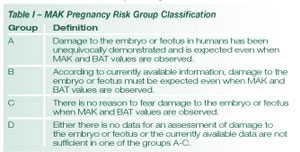Six reasons why Germany’s MAK — Maximum Concentration Values in the Workplace — should be recognized and applied in U.S. worksites:
1. ACGIH® Reference
The ACGIH® Guide to Occupational Exposure Values is a standard reference used by people who prepare a OSHA GHS-compliant Safety Data Sheet (SDS). Table headings for each chemical in the Guide include: ACGIH® TLV®; OSHA PELs; NIOSH RELs; DFG MAKs; AIHA WEELs; and, Carcinogenicity Category. The ACGIH® Guide considers the MAK a standard reference OEL.
2. International Chemical Safety Cards (ICSCs)
OSHA suggests in the preamble to HazCom/Global Harmonization Standard (GHS) (ref. FR Vol. 77, No. 58, March 26, 2012, page 17723) that ICSCs, currently covering 1,650 substances, be a GHS classification database source. The MAK is included at the OEL section of ICSCs.
3. Safety Data Sheets
GHS means that SDSs will have a specific layout and specific content. Within OSHA HazCom/GHS, OELs include PELs and TLVs® but also, “… any other exposure limit used or recommended by the chemical manufacturer, importer, or employer preparing the Safety Data Sheet …” Because of information in #1 and #2 above, look for more MAK data on SDSs.
4. MAK Unique Data
The OSHA HazCom/GHS standard introduces U.S. worksites to the special hazards of chemicals classified for Germ Cell Mutagenicity (ref. Appendix C.4.8) and Toxic to Reproduction (ref. Appendix C.4.10). The MAK provides unique data on mutagens and pregnancy risk that cannot be found with PELs, TLVs, RELs, or WEELs. Table I below is an example of this unique data.
Because the OSHA HazCom/GHS standard now requires where applicable for some chemicals the risk statement, “May damage fertility or the unborn child” MAK information in Table I may be indispensable.
5. Band Wagon
In May 2012, the Federal Advisory Council on Occupational Safety and Health proposed that the U.S. Secretary of Labor adopt OELs “published by other agencies, professional organizations, and other foreign or domestic entities” for use by federal agencies to help protect Federal employees and employees of contractors that provide services to the Federal Government. The MAK was specifically included as a referenced OEL. Actions by FACOSH may prompt other organizations and individuals to follow similar actions.
6. Risk Management
Under ISO 31000:2009 Principles and Guidance on Risk Management, organizations may apply OELs as a risk assessment tool to help meet objectives. The context of risk e.g. regulatory trends, perceptions and values of shareholders, etc. must also be considered during the risk assessment.
As an independent OSH consultant, I’ve been aware of the MAK my entire career. However, because of recent events, most particularly the risk information in items #1-5 above, as part of my current due diligence and standard of care, I now will advise all clients about use of the MAK at U.S. worksites.
Are you competent to apply the MAK?
Many issues must be considered before your organization applies the MAK. A key understanding for the MAK and all OELs is that they are, in the words of ACGIH® particularly for the TLV®, “not fine lines between safe and dangerous concentrations and should not be used by anyone untrained in the discipline of industrial hygiene.”
The FACOSH report in item #5 above identifies qualifications for someone to apply OELs. Qualifications include holding the CIH®, CSP®, PE, CHMM, QEP or ABT credential. Other qualifications include being a GS-0690-11 or above or having a B.S. degree in science or engineering from an accredited institution, i.e. recognized by the U.S. Secretary of Education along with five years of progressive experience — knock this down to four years of progressive experience if you have a M.S. degree in science or engineering.
Think global, act local
OSHA HazCom/GHS is pushing U.S.-based OSH pros to become more aware of how global information on chemicals impact local actions. As the MAK appears more and more on SDSs there will be an obligation to inform employees of what the letters mean.




